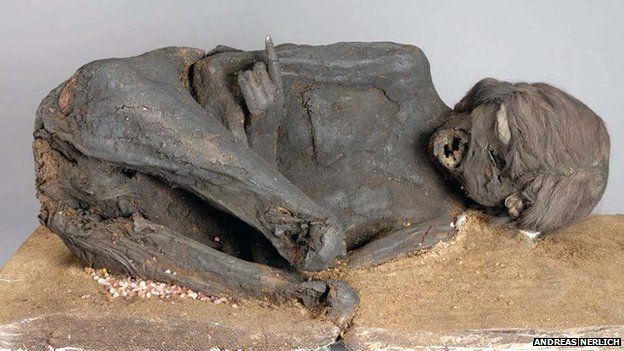South American mummy ritually sacrificed
- Published

A previously unidentified female mummy was killed in a ritual sacrifice in South America, new research has found.
A team of scientists analysed the skull to find evidence of a blunt trauma to the head, suggesting she died very quickly from the blow.
DNA analysis also revealed she suffered from a parasitic infection called Chagas disease, they write in Plos One.
Her symptoms indicated she would not have lived for much longer even if she had escaped her killers.
Chagas is still endemic in South America - especially those living in poverty - and can be deadly if not treated early.
Andreas Nerlich, co-author of the study from Munich University, Germany, said that the girl was likely to have come from a poor family.
"The parasite lives in mud-brick walls typical of those from lower social classes, not in stone houses or better equipped, cleaner surroundings," he told BBC News.
For more than 100 years, it was unclear where the mummy was from, but now detailed CT scans, injury reconstructions and DNA evidence have finally given clues to her origin.
The mummified woman is over 500 years old, and would have died in her early 20s.
She is thought to have arrived in Germany after a Bavarian princess brought her back from an expedition to South America in 1898.
Where exactly she would have lived remains unclear, but based on a stable isotope analysis of her bones and hair, her diet was rich in fish. The researchers therefore suggest she lived near the Peruvian or Northern Chilean coast line.
The rope which tied her plaits was made out of material that originated in South America and her skull formation was also typical of the Inca people.
She was killed and buried in a hot and dry sandy region that resulted in natural mummification. For many years, however, it was simply assumed she was a German bog body.
"We assumed she died in a ritual killing but we have no clear evidence from written sources," explained Prof Nerlich.
"Present-day techniques offer such a wealth of information that we can reconstruct various aspects of past lives, diseases and death."
The analysis will now help scientists understand the origin of the Chagas pathogen and its molecular construction.
Evidence of ritual sacrifice in South American mummies is well documented.
In the Incan empire, young girls were often given up to the sun god in religious rituals. The parents and local communities of sacrificed victims were consequently highly respected.
Emma Brown from the department of archaeological sciences at the University of Bradford, UK, who was not involved with the study, said that due to the lack of contextual data it was hard to definitively say that the mummy was a human sacrifice.
"This individual is older than the usual profile of ritually killed females, who are typically around the age of 13 or 14," Dr Brown told the BBC.
"It is important to recognise the historical context of this mummy. The radiocarbon dates cover the period of the Spanish conquest of the Americas.
"Historical records describe repressive and extreme forms of violence and recent bio-archaeological investigations of conquest-era cemeteries have revealed that many types of trauma, including massive blunt force cranial trauma [shown here] are quite common," she added.
- Published30 July 2013
- Published30 July 2013